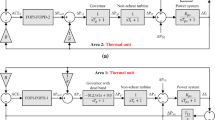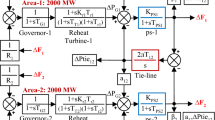Abstract
This article deals with automatic generation control (AGC) of a three-area power system having five diversified sources of generation like thermal unit, hydro unit, wind unit, diesel unit and a gas unit are interconnected together. Area-1 of the power system consists of a thermal, a hydro and a wind unit, area-2 has a thermal, a hydro and a diesel unit and area-3 consists of a thermal, a hydro and a gas unit. To make system more realistic different nonlinear components like governor dead band (GDB), generation rate constraint (GRC), boiler dynamics and communication delay are taken into account. A novel two-degree of freedom fractional order PID with derivative filter and fractional order PD with derivative filter (2-DOF-FOPIDN-FOPDN) cascaded control strategy is adopted to improve the dynamic performance of the power system. The results obtained with the proposed cascaded controller are compared with that of PID, FOPID and 2-DOF-PIDN-PDN cascaded controller to prove its superiority. To enumerate the gains of different controllers optimally, a recently developed bio-inspired optimisation algorithm named selfish herd optimisation (SHO) is capitalised. Further, the work is extended by taking a two-area hydro-thermal system to compare the result of the SHO tuned PID controller with that of modern hybrid firefly algorithm-pattern search (hFA-PS) technique. Transient analysis is carried out by applying a sudden load disturbance of 0.01 p.u in area-1 and the robustness of the controller is examined by varying both system parameters and applying a randomly varying load in area-1. From the investigation it is concluded that the 2-DOF-FOPIDN-FOPDN controller gives a flawless and a distinct performance.










Similar content being viewed by others
References
Abdel-Magid YL, Abido MA (2003) AGC tuning of interconnected reheat thermal systems with particle swarm optimization. In: Electronics, circuits and systems, 2003. ICECS 2003. Proceedings of the 2003 10th IEEE international conference, vol 14, no 1, pp 376–379
Acharyulu BVS, Mohanty B, Hota PK (2019) Performance analysis of a cascade controller for conventional and deregulated power systems. Int J Model Simul 1–19
Bhatt P, Roy R, Ghoshal SP (2010) GA/particle swarm intelligence-based optimization of two specific varieties of controller devices applied to two-area multi-units automatic generation control. Int J Electr Power Energy Syst 32(4):299–310
Bhise GG, Kothart ML, Nanda J. (1993) Optimum selection of hydrogovernor parameters for automatic generation control of a hydrothermal system. In: 2nd International conference on advances in power system control, operation and management, 1993. APSCOM-93. pp 910–915
Dash P, Saikia LC, Sinha N (2015) Automatic generation control of multi area thermal system using Bat algorithm optimized PD–PID cascade controller. Int J Electr Power Energy Syst 68:364–372
Dash P, Saikia LC, Sinha N (2016) Flower pollination algorithm optimized PI-PD cascade controller in automatic generation control of a multi-area power system. Int J Electr Power Energy Syst 82:19–28
Elgerd OI, Fosha CE (1970) Optimum megawatt-frequency control of multiarea electric energy systems. IEEE Trans Power Appar Syst 4:556–563
Fausto F, Cuevas E, Valdivia A, González A (2017) A global optimization algorithm inspired in the behavior of selfish herds. Biosystems 160:39–55
Gozde H, Taplamacioglu MC (2011) Automatic generation control application with craziness based particle swarm optimization in a thermal power system. Int J Electr Power Energy Syst 33(1):8–16
Gozde H, Taplamacioglu MC, Kocaarslan I (2012) Comparative performance analysis of Artificial Bee Colony algorithm in automatic generation control for interconnected reheat thermal power system. Int J Electr Power Energy Syst 42(1):167–178
Guha D, Roy PK, Banerjee S (2018) Symbiotic organism search algorithm applied to load frequency control of multi-area power system. Energy Syst 9(2):439–468
Hassan MF, Abouelsoud AA, Soliman HM (2008) Constrained load-frequency control. Electr Power Compon Syst 36(3):266–279
Kothari ML, Nanda J, Kothari DP, Das D (1989) Discrete-mode automatic generation control of a two-area reheat thermal system with new area control error. IEEE Trans Power Syst 4(2):730–738
Morsali J, Zare K, Hagh MT (2017a) Applying fractional order PID to design TCSC-based damping controller in coordination with automatic generation control of interconnected multi-source power system. Eng Sci Technol Int J 20(1):1–7
Morsali J, Zare K, Hagh MT (2017b) MGSO optimised TID-based GCSC damping controller in coordination with AGC for diverse-GENCOs multi-DISCOs power system with considering GDB and GRC non-linearity effects. IET Gener Transm Distrib 11(1):193–208
Nanda J, Mishra S, Saikia LC (2009) Maiden application of bacterial foraging-based optimization technique in multiarea automatic generation control. IEEE Trans Power Syst 24(2):602–609
Nayak JR., Shaw B, Sahu BK (2020) Novel application of optimal fuzzy‐adaptive symbiotic organism search‐based two‐degree‐of‐freedom fuzzy proportional integral derivative controller for automatic generation control study. Int Trans Electr Energy Syst
Oustaloup A, Levron F, Mathieu B, Nanot FM (2000) Frequency-band complex non integer differentiator: characterization and synthesis. IEEE Trans Circuits Syst I Fundam Theory Appl 47(1):25–39
Pan I, Das S (2016) Fractional order fuzzy control of hybrid power system with renewable generation using chaotic PSO. ISA Trans 62:19–29
Pandey SK, Mohanty SR, Kishor N (2013) A literature survey on load–frequency control for conventional and distribution generation power systems. Renew Sustain Energy Rev 25:318–334
Podlubny I (1999) Fractional-order systems and PI/sup/spl lambda//D/sup/spl mu//-controllers. IEEE Trans Autom Control 44(1):208–214
Raj U, Shankar R (2020) Deregulated automatic generation control using novel opposition-based interactive search algorithm cascade controller including distributed generation and electric vehicle. Iran J Sci Technol Trans Electr Eng 1–19
Saha A, Saikia LC (2017) Utilisation of ultra-capacitor in load frequency control under restructured STPP-thermal power systems using WOA optimised PIDN-FOPD controller. IET Gener Transm Distrib 11(13):3318–3331
Sahu RK, Panda S, Rout UK (2013) DE optimized parallel 2-DOF PID controller for load frequency control of power system with governor dead-band nonlinearity. Int J Electr Power Energy Syst 49:19–33
Sahu BK, Pati S, Panda S (2014) Hybrid differential evolution particle swarm optimisation optimised fuzzy proportional–integral derivative controller for automatic generation control of interconnected power system. IET Gener Transm Distrib 8(11):1789–1800
Sahu RK, Panda S, Sekhar GC (2015a) A novel hybrid PSO-PS optimized fuzzy PI controller for AGC in multi area interconnected power systems. Int J Electr Power Energy Syst 64:880–893
Sahu BK, Pati S, Mohanty PK, Panda S (2015b) Teaching–learning based optimization algorithm based fuzzy-PID controller for automatic generation control of multi-area power system. Appl Soft Comput 27:240–249
Sahu RK, Panda S, Padhan S (2015c) A hybrid firefly algorithm and pattern search technique for automatic generation control of multi area power systems. Int J Electr Power Energy Syst 64:9–23
Sarma U, Saikia LC, Sana A, Dash P (2016) Load frequency control of a multi-area, multi-source system using firefly algorithm optimized F2DOFIDD controller. In: Region 10 conference (TENCON). IEEE, pp 1475–1479
Saxena S (2019) Load frequency control strategy via fractional-order controller and reduced-order modeling. Int J Electr Power Energy Syst 104:603–614
Shabani H, Vahidi B, Ebrahimpour M (2013) A robust PID controller based on imperialist competitive algorithm for load-frequency control of power systems. ISA Trans 52(1):88–95
Shankar R, Pradhan SR, Chatterjee K, Mandal R (2017) A comprehensive state of the art literature survey on LFC mechanism for power system. Renew Sustain Energy Rev 76:1185–1207
Sharma Y, Saikia LC (2015) Automatic generation control of a multi-area ST–Thermal power system using grey wolf optimizer algorithm based classical controllers. Int J Electr Power Energy Syst 73:853–862
Shayeghi HA, Shayanfar HA, Jalili A (2009) Load frequency control strategies: a state-of-the-art survey for the researcher. Energy Convers Manag 50(2):344–353
Sitikantha D, Sahu BK, Mohanty PK (2020) Implementation of WOA-based 2DOF-FOPID controller for AGC of interconnected power system. In: Computational intelligence in pattern recognition. Springer, Singapore, pp 909–920
Subha S (2014) Load frequency control with fuzzy logic controller considering governor dead band and generation rate constraint non-linearities. World Appl Sci J 29(8):1059–1066
Swain AK, Mohanty AK (1995) Adaptive load frequency control of an interconnected hydro thermal system considering generation rate constraints. J Inst Eng India PART Electr Eng Div 76:109–114
Tasnin W, Saikia LC (2018) Performance comparison of several energy storage devices in deregulated AGC of a multi-area system incorporating geothermal power plant. IET Renew Power Gener 12(7):761–772
Tripathy SC, Balasubramanian R, Nair P (1992) Effect of superconducting magnetic energy storage on automatic generation control considering governor deadband and boiler dynamics. IEEE Trans Power Syst 7(3):1266–1273
Zamani A, Barakati SM, Yousofi-Darmian S (2016) Design of a fractional order PID controller using GBMO algorithm for load–frequency control with governor saturation consideration. ISA Trans 64:56–66
Author information
Authors and Affiliations
Corresponding author
Ethics declarations
Conflict of interest
There is no conflict of interest.
Additional information
Publisher's Note
Springer Nature remains neutral with regard to jurisdictional claims in published maps and institutional affiliations.
Appendices
Appendix A
\(K_{ps} = 120,\,T_{ps} = 20s,\,R_{x} = R_{y} = R_{z} = 2.4,\,B_{1} = B_{2} = B_{3} = 0.425,\,T_{12} = T_{23} = T_{31} = 0.0707,\,a_{12} = a_{13} = a_{23} = - 1.\)
Thermal Units:
\(T_{g1} = 0.2\,s\), \(T_{t} = 0.3\,s\), \(T_{r} = 10\,s\), \(K_{r} = 0.333\,\), \(N_{1} = 0.8\), \(N_{2} = - 0.2\), \(K_{1} = 0.85\), \(K_{2} = 0.095\), \(K_{3} = 0.92\), \(c_{B} = 200\), \(K_{ib} = 0.5\), \(T_{ib} = 26\,s\), \(T_{rb} = 69\,s\), \(T_{D} = 0\), \(T_{F} = 10\,s\), \(T_{t} = 0.3\,s\).
Hydro Units:
\(T_{g2} = 48.7\,s\), \(T_{1} = 0.513\,s\), \(T_{2} = 10\,s\), \(T_{w} = 1s\).
Gas Unit:
\(C_{GS} = 1\), \(B_{GS} = 0.05\), \(X_{GS} = 0.6\), \(Y_{GS} = 1\), \(T_{CR} = 0.01\,s\), \(T_{FR} = 0.23\,s\), \(T_{CD} = 0.2\,s\).
Wind Farm & Diesel Unit:
\(k_{2} = 1.25\), \(k_{3} = 1.4\), \(T_{p1} = 0.6\,s\), \(T_{p2} = 0.041\,s\), \(k_{diesel} = 16.5\,\).
Appendix B
\(K_{ps} = 120\), \(T_{ps} = 20s\), \(B_{1} = B_{2} = 0.425\), \(R_{1} = 2\), \(R_{2} = 2.4\), \(T_{12} = 0.0707\), \(a_{12} = - 1\).
Thermal Units:
\(T_{g} = 0.08\,s\), \(T_{t} = 0.3\,s\).
Hydro Units:
\(T_{g} = 48.7\,s\), \(T_{H1} = 0.513\,s\), \(T_{H2} = 10\,s\), \(T_{w} = 1s\).
Rights and permissions
About this article
Cite this article
Sahoo, S., Jena, N.K., Ray, P.K. et al. Selfish Herd Optimisation tuned fractional order cascaded controllers for AGC Analysis. Soft Comput 26, 2835–2853 (2022). https://doi.org/10.1007/s00500-021-06518-2
Accepted:
Published:
Issue Date:
DOI: https://doi.org/10.1007/s00500-021-06518-2




